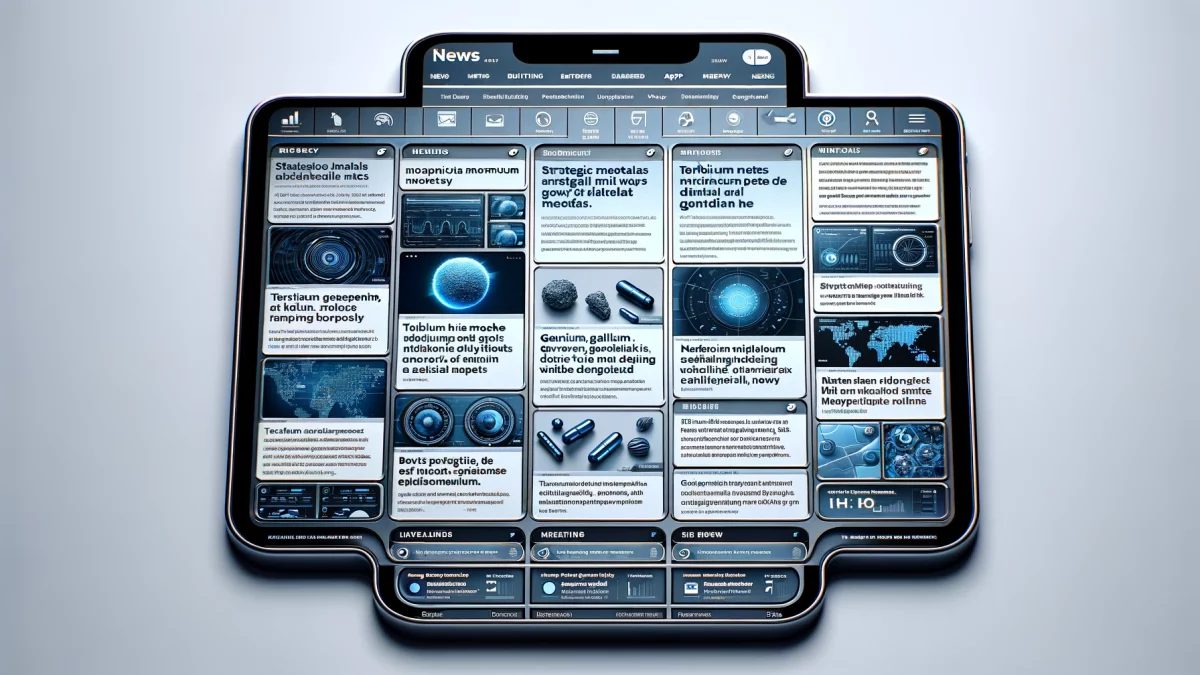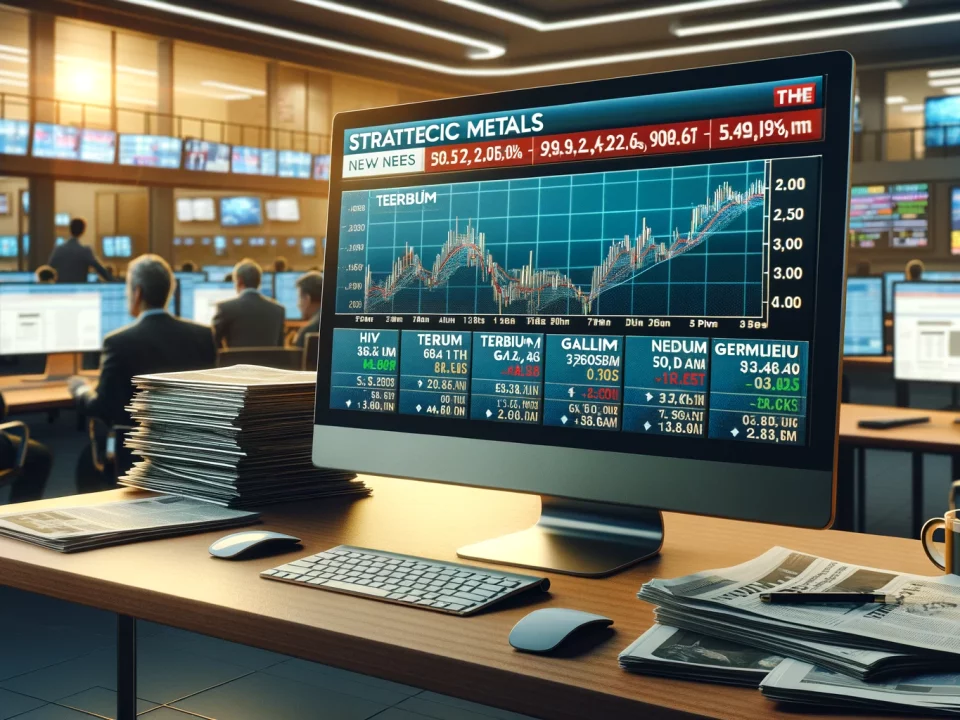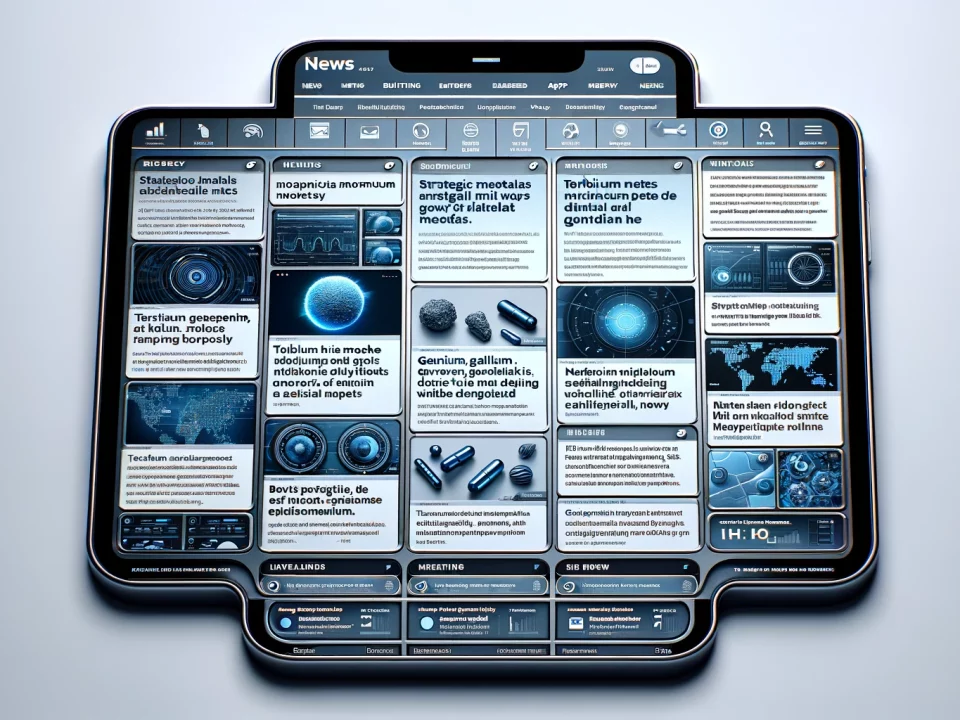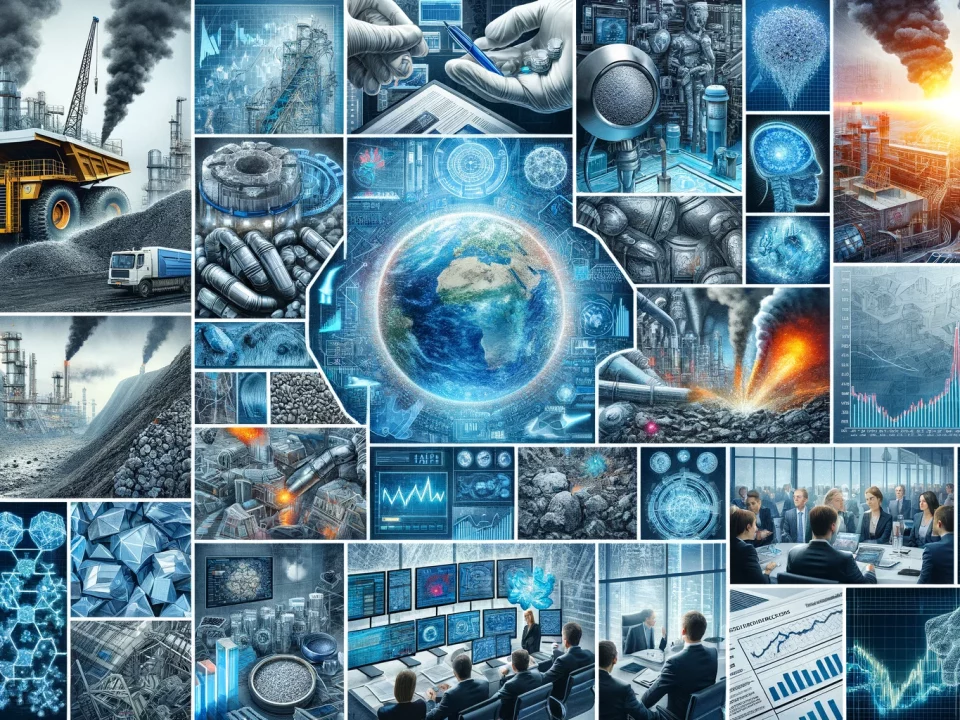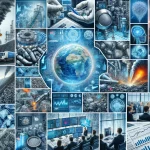
Weekly News Review Mar 11 – Mar 17 2024
March 17, 2024
Maximize Your Bitcoin Gains: Why Strategic Metals Are Your Next Smart Move
March 28, 2024Welcome to our weekly news review.
SEMICONDUCTORS: INTEL SECURES ALMOST $20 BILLION FROM US GOVERNMENT –
The most significant single expenditure in the sector is aimed at bolstering the domestic semiconductor industry.
U.S. semiconductor giant Intel has secured almost $20 billion in grants and loans from the U.S. Government.
President Joe Biden announced the support during a Wednesday visit to Intel’s Ocotillo Campus in Chandler, Arizona. The investment marks the most significant single expenditure by the U.S. Government in the sector. According to the factsheet published by the White House, the Government will provide up to $8.5 billion in direct funding along with $11 billion in loans under the CHIPS and Science Act.
The investment aims to construct or expand Intel’s facilities spread across four states: Arizona, New Mexico, Ohio, and Oregon. According to the factsheet, it is set to create up to 30,000 jobs. The statement added that the chips produced in the modernized plants are essential to high-tech fields like artificial intelligence.
Under the CHIPS and Science Act, the U.S. provides billions in funding and loans for manufacturing projects, commercialisation, and supply chains to catalyse domestic chip production and accelerate semiconductor output. Last month, GlobalFoundries, another major U.S. chip manufacturer, received $1.5 billion for similar projects.
EU CRITICAL RAW MATERIALS ACT (CRMA) REACHES THE FINISHING LINE:
The EU Council gives final approval, and the first Europe-wide law on the supply of critical minerals will come into force in a few weeks.
The EU Council, representing the 27 Member States, today approved the first European law on the supply of critical raw materials (CRMA). According to the press release, this is the final step in the decision-making process; the law will come into force in just a few weeks before being published in the Official Journal of the European Union.
The CRMA focuses on 34 critical materials, 17 of which are also strategic and classified as crucial for the ecological and digital transformation and the defence and space industries. The central objectives of the new law relate to the annual consumption of these raw materials in the EU: by 2030, 10 per cent are to be covered by domestic mining, 40 per cent are to be processed in the EU, and 25 per cent are to come from recycling. In addition, the association of states is dependent on imports from a single third country for a maximum of 65% of each strategic raw material. Other requirements include significantly accelerated approval procedures for raw material projects such as mines, supply chain risk assessments, and national exploration plans.
Just under a year has passed since the CRMA was first presented; after the coronavirus pandemic and Russia’s attack on Ukraine exposed major dependencies in European supply chains, securing raw materials moved high up the political agenda.
MALAYSIA EYES CHINESE EXPERTISE TO ADVANCE STRATEGIC METALS SECTOR:
Minister to visit China next month to seek out investment into a rare earth refinery.
Southeast Asian country Malaysia is looking to China to advance its rare earth sector and curb illegal mining activities. According to the Malaysian newspaper The Straits Times, the minister for science, technology, and innovation, Chang Lih Kang, will visit China in April to seek out investments in a rare earth refinery in Malaysia. The move would advance plans to streamline and modernize the sector. However, China imposed export bans on rare earth refining and separation technologies in December 2023, so it is unclear to what extent Beijing would make an exception for Malaysia’s aspiring critical minerals sector.
Malaysia is already home to a rare earth refinery operated by Australian miner Lynas. The feedstock, however, originates from Australia. A self-operated refinery that uses Malaysian raw materials would be a key element in plans to unlock the economic potential of the critical minerals used in clean energy and electric vehicle technologies. The Malaysian Government announced the discovery of rare earth deposits of around 16 million tons last year, followed by banning the export of unprocessed rare earth products from January 2024 to “guarantee maximum returns for the country.”
Exporting processed critical minerals yields higher returns than shipping out raw ores. In the same vein, the governments of the Malaysian states of Pahang and Perak pushed for establishing a Malaysian rare earth value chain including the processing stage.
RECYCLING OF RARE EARTH MAGNETS – COOPERATION BETWEEN CANADA AND GERMANY ANNOUNCED:
The partnership advances the development of Western supply chains for the energy transition.
German company Vacuumschmelze (VAC), one of the few producers of rare earth magnets outside of China, is partnering with Cyclic Materials, a Canadian start-up building a circular supply chain for critical raw materials. The agreement signed on Monday provides for recycling high-performance permanent magnets containing rare earths, which are essential components for electric vehicles, wind turbines, and modern electronics. A process developed by Cyclic Materials will be used, while VAC will provide local sources of raw materials and decades of experience in rare earth magnet technology, according to the press release. The return of permanent magnets to the supply chain is an alternative to mining, said Ahmad Ghahreman, co-founder and CEO of the Canadian company, which will reduce the carbon footprint by 75 per cent.
With this cooperation, the Western supply chains for critical raw materials continue to take shape. Just last week, South Korean companies Posco and Star Group announced the production of permanent magnets using raw materials from sources outside China, while the Canadian and Australian governments pledged funding for the construction of domestic rare earth facilities.
INTERNATIONAL RENEWABLE ENERGY AGENCY (IRENA) URGES GLOBAL COURSE CORRECTION TO MEET CLIMATE TARGETS:
To reach the global target set at COP28 to triple renewable power capacity by 2030, a ramping up of investments and dedicated policy support is needed, according to the International Renewable Energy Agency (IRENA). While the agency highlights that in 2023, a record 473 gigawatts (GW) were added to the global energy mix, it said that an average of almost 1,100 GW – more than double the record of 2023 – of renewables capacity must be installed annually to meet the target. To achieve this, IRENA added that annual investments in renewable energies must triple from $570 billion in 2023 to $1,550 billion on average between 2024 and 2030.
Besides a lack of investments, the IRENA also sees geopolitical rifts as challenges for the energy transition. In a report last year, the agency advocated for supply chain diversification of critical minerals to mitigate these risks.
GALLIUM AND GERMANIUM: CHINESE RESTRICTIONS ON EXPORTS AFFECTING THE MARKET –
The export of gallium and germanium from China declined in the first two months of the year, according to the latest figures from the customs authorities published Wednesday.
The People’s Republic shipped significantly less of the two critical materials important for civilian and military technologies year over year.
Gallium even declined to below half the amount exported in December 2023 alone.
This shows that the export restrictions in force since August 2023 still affect the market. Companies must apply for licenses to ship the two metals abroad. China exported 3,709 kilos of germanium and 2,760 kilos of gallium from January to February.
CRITICISM FROM CHINA – QUESTIONS IN EUROPE – GLOBAL REACTION TO THE EU’S CRITICAL RAW MATERIALS ACT (CRMA).
The act aims to strengthen the EU raw materials sector. Besides praise, there is also scepticism.
On Monday, the EU Council gave the green light for the Critical Raw Materials Act (CRMA), with which the EU wants to strengthen its raw materials sector and make it less dependent on imports. The law will, therefore, officially come into force in just a few weeks. The CRMA lists 34 critical raw materials, 17 of which are also designated as strategically important and are, therefore, crucial for the economy, climate targets, and future technologies. Under the act, ten per cent of the EU’s annual demand for these strategic raw materials must stem from domestic mining by 2030. 40 per cent should be processed in the EU, and 25 per cent should come from recycling. Another central pillar is the diversification of supply chains: no strategic raw material should depend on imports from a single third country for more than 65 per cent of its supply. The EU wants to achieve these goals primarily by speeding up approval procedures for raw material projects, facilitating investments, and constant risk assessments.
China Has Words of Warning –
The country indirectly addressed by the CRMA has now responded: China, from which the EU currently sources a large proportion of its critical raw materials. The main aim of the law is to reduce this dependency. On Tuesday, the Chinese Chamber of Commerce addressed EU representatives in a state-affiliated Global Times statement warning that attempts to mitigate and substitute raw material supplies from China pose challenges to mutual trade relations. Europe is harming itself through higher costs for the energy transition and digitalization of the economy.
European Industry Sees Open Questions –
However, Europe’s domestic industry and research were initially somewhat cautious after the first presentation of the draft legislation last year and still saw a need for action. While a study by the University of Cambridge Institute for Sustainability Leadership (CISL) and the Wuppertal Institute criticized the initial recycling rate as too low, the Federation of German Industries (BDI) found reasons for improvement alongside words of praise. According to the BDI, the success of the CRMA would depend on its actual implementation, and accelerated procedures would only be one building block for greater European independence. In addition, social acceptance for projects along the entire value chain would have to be established, the BDI continued. The references to other EU programs and the member states in investment matters also did not go far enough.
US OFFERS $850 MILLION IN FUNDING FOR AUSTRALIAN AND BRAZILIAN RARE EARTHS PROJECTS:
Loans aim to bolster Western supply chains of critical minerals but are tied to environmental approvals.
The Export-Import Bank of the United States sent a non-binding letter of interest to two Australian companies developing rare earth projects in Australia and Brazil. According to media statements by Australian Strategic Materials and Meteoric Resources, the U.S. offers a total of $850 million for the two ventures: $600 to advance ASM’s Dubbo project in New South Wales and $250 million for Meteoric’s Caldeira Project located in the Brazilian state of Minas Gerais.
The funding comes amid a push by Western nations and their allies to diversify supply chains away from industry leader China. The People’s Republic currently accounts for almost 70 per cent of the world’s production of rare earth elements, data from the U.S. Geological Survey shows. These critical minerals are needed for high-power permanent magnets in electric vehicles and clean energy fields. Despite this overarching goal, the companies added that the final approval for the two loans is subject to environmental approval and due diligence.
Australia recently moved into the centre stage of the rare earth sphere. Last week, Arafura, another major rare earth player from Down Under, received $533 million in government support to develop the country’s first ore-to-oxide mine and processing facility.
EU AND NORWAY FORGE STRATEGIC PARTNERSHIP FOR STRATEGIC METALS:
The bloc will also be attentive to deep-sea mining developments.
On Thursday, the European Union and Norway signed a Memorandum of Understanding (MoU) to launch a strategic partnership on developing sustainable land-based raw materials and battery value chains. According to a statement by the European Commission, the partnership will facilitate joint investments and collaborations in the sector to bolster the European raw materials industry and render the two economies more resilient to supply chain disruptions.
The caveat of “land-based” likely addresses Norway’s recent push to accelerate its deep-sea mining efforts. The EU and individual member states such as Germany have repeatedly called for a memorandum on issuing exploration rights until environmental impacts have been better assessed. However, the signing of the MoU on Thursday was also accompanied by the EU’s Green Deal chief, Maroš Šefčovič, who also signed the strategic partnership, saying that the bloc will be “attentive to the developments of deep sea mining in Norway and also around the world,” Bloomberg reports. Šefčovič added that more mineral mining must happen to fuel the green and digital transition, highlighting the quandary countries around the world face: balancing mining with environmental efforts.
Besides deep-sea resources, Norway is also home to significant land-based resources, which it is currently trying to develop, for example, the Fen rare earth deposit in the southeastern region of Telemark.
For example, nations on the path to net zero need critical minerals for clean energy fields but are increasingly dependent on imports from foreign partners. The EU is currently attempting to address this discrepancy with the Critical Raw Materials Act, which sets out domestic mining, processing, and recycling targets.
Despite not being in the EU, Norway could nonetheless become an important partner to achieve these targets.
GROWING AMOUNTS OF ELECTRONIC WASTE WORLDWIDE – RECYCLING LAGGING BEHIND:
A UN report shows that billions of euros of raw materials are lost, and recycling covers just one per cent of the demand for rare earthS.
More and more e-waste is generated worldwide—its production is increasing five times faster than documented recycling, according to the latest United Nations (UN) Global E-waste Monitor. In 2022, a record amount of 62 million tons of e-waste was produced, enough to fill 1.55 million 40-tonne trucks that would stretch around the equator, according to the report. At 17.6 kilos, Europe has the highest volume of e-waste per capita.
Some other impressive figures: Compared to 2010, the number of discarded and sorted electrical appliances increased by 82 per cent in 2022. By 2030, the annual volume is expected to rise to 82 million tons.
In addition to increasing the burden on the environment and health, wasting valuable resources is also problematic. The UN reports that billions of dollars of raw materials are lost.
In 2022, only 22.3 percent of the e-waste generated was properly collected and recycled. For 2030, the report predicts a 20 percent decline, triggered, among other things, by ever-increasing consumption, shorter product life cycles, and inadequate infrastructure for handling e-waste.
The UN concludes by calling for significantly higher collection and recycling rates, which could improve the supply of rare earths in particular. These critical raw materials are primarily needed for electric motors, wind turbines, and consumer electronics. While China has a quasi-monopoly on extraction and processing, and many countries want to reduce their dependence on imports, only one per cent of the demand for rare earth has so far been covered by recycling.
However, initial steps have been taken to improve this situation. The EU’s Critical Raw Materials Act, which will come into force in a few weeks, provides for significantly increased recycling quotas for important raw materials by 2030. Research initiatives and companies are also increasingly focusing on this field, in some cases with government funding.



